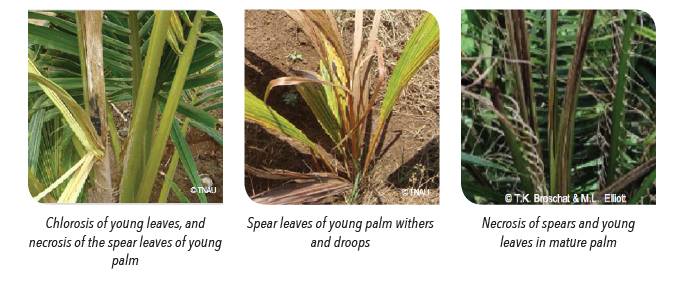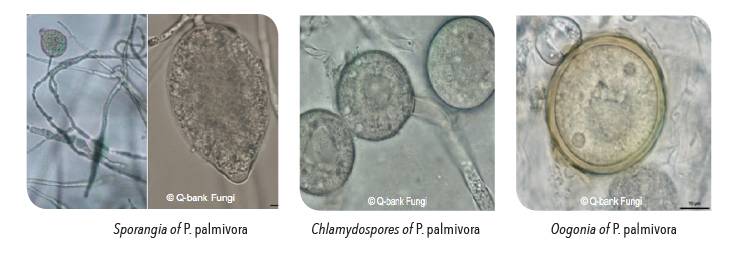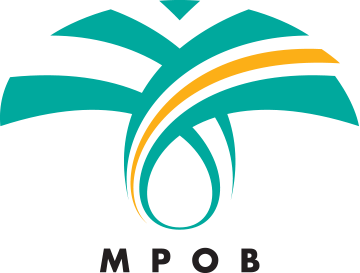General Information

Bud rot, caused by Phytophthora palmivora, is one of the major diseases of oil palm in Latin America. The disease affect the yield of fresh fruit bunches (FFB) and the quality of the crude palm oil extract. In Colombia, the disease has affected more than (a) 30 000 ha in the South West Colombia and (b) 10 000 ha in the Central Zone. The infection affects oil palm of all stages: nursery to the end of the production cycle. Young palms are more susceptible.
Bud rot is not lethal to oil palm in most cases, but affected palms may require up to three years to recover. During the recovery period, fruit production declines significantly. The infection starts off with the yellowing of young leaves during the months of high rainfall and high relative humidity. Affected leaf tissue becomes necrotic and dies as the disease progresses. The disease is most serious when fungal pathogen infects the meristematic palm tips. Palms can recover if the infection is superficial. The disease is fatal when deeper meristematic tissues are infected; even drastic control measures such as heavy pruning will not be able to save the palm. In seedlings, the spear leaf turns pale, and comes off easily with a soft tug.
P. palmivora is already present in Malaysia affecting other plant hosts e.g. cocoa, durian, pepper, rubber, coconut, betelnut and papaya. Disease incidence on oil palm has not yet been recorded in the country.
Distribution
Tropic and subtropical regions of the USA; Latin America; Southeast Asia; Africa; Europe; Oceania; India.
Detection and Inspection
Direct isolation from infected plant tissues is the most practical and effective diagnostic method. P. palmivora can be detected through laboratory culture.
Sporangia may occur on fruits, pods and leaves, and can be mounted on directly on slides and viewed under a light microscope. This enables confirmation to the genus level. A culture is required for identification to species level.
Real-time PCR and molecular beacon probes can also be used for early detection of infected tissues. The A2/I2 primers (specific to the genus Phytophthora) is used to amplify a 788- bp fragment located in the internal transcribed spacer (ITS) region. The PCR product is then digested with the restriction enzymes MspI, RsaI, and TaqI, to generate fragments specific to the species P. palmivora.
Prevention and Control
PHYTOSANITARY
The import of germplasm material (seeds, pollen, tissue culture) must be accompanied by an import permit issued by or on behalf of the Director-General Department of Agriculture for Peninsular Malaysia (including Labuan), or the Director Department of Agriculture for Sabah, and a phytosanitary certificate issued by an authorised official from the country of export. The import conditions are available upon request from the Plant Biosecurity Division Malaysia. All consignments are subjected to inspection by the Department of Agriculture prior to clearance by Customs. Germplasm material imported from high risk areas should be sent for third country quarantine and molecular diagnosis before arrival onto Malaysian shores. P. palmivora is a soil-borne pathogen. Importation of potting material/soil from high risk countries to be enquired with DOA.

CULTURAL CONTROL AND SANITARY METHODS
Establishment of adequate drainage and adequate, balanced soil fertility. In areas where Phytophthora has not been recorded, exclusion is essential – exclude animals by fencing, limit movement of vehicles and people through the field, clean soil from vehicles, boots and tools before they are brought into the field, plant only disease-free palms/ other crops, and divert water run-off from adjacent field with known incidence of bud rot. In nurseries, potting material to be steamed to kill Phytophthora inoculum.
Further reading
- Acosta, A and Munevar, F (2003). Bud rot in oil palm plantations: Link to Soil Physical Properties and Nutrient Status. Better Crops Int. 17(2): 22-25.
- Álvarez, E; Marroquin-Guzman, M; Mejia, J F and Pardo, M (2010). Early detection of Phytophthora palmivora in oil palm, using real-time polymerase chain reaction (QPCR) and molecular beacon probes. Plant Pathology Program, Tropical Fruit Project, International Center for Tropical Agriculture (CIAT), Cali, Valle del Cauca, Colombia. Phytopathology, 101: S253.
- CABI CPC (2014). Phytophthora palmivora (coconut budrot). URL: http://www.cabi.org/cpc/
- Drenth, A and Guest, D I (2004). Principles of Phytophthora Disease Management. In Diversity and Management of Phytophthora in Southeast Asia. ACIAR Monograph 114.
- Elliott, M L (2015). Bud Rot of Palm. IFAS Extension. URL: https://edis.ifas.ufl.edu/pdffiles/PP/PP14400.pdf
- Kueh, T K and Khew, K L (1982). Survival of Phytophthora palmivora in soil and after passing through alimentary canals of snails. Plant Dis. 66: 897-899.
- Paterson, R R M; Sariah, M and Lima, N (2013). How will climate change affect oil palm fungal diseases? Crop Protection, 46: 113-120.
- Q-Bank Fungi (2015). Phytophthora palmivora. URL: http://www.q-bank.eu/Fungi/BioloMICS. aspx? Table=Phytophthora%20species%20 ONLINE&Rec=592&Fields=All.
- TNAU (2015). Pest and Disease Management. URL: http://agritech.tnau.ac.in/expert_system/coconut/ coconut/ coconut_pest%20and_diseases.html#bud_ rot.
- Torres, G A; Sarria, G A; Varon, F; Coffey, M D; Elliott, M L and Martinez, G (2010). First report of bud rot caused by Phytophthora palmivora on African oil palm in Colombia. Plant Dis. 94(9): 1163.

